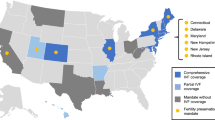Abstract
Purpose
Infertility affects one in four female physicians, yet current availability of fertility benefits within Accreditation Council for Graduate Medical Education (ACGME) accredited residency programs in the United States (US) is unknown. Our objective was to examine publicly available fertility benefits information for residents and fellows.
Methods
The top 50 medical schools in the US for research were identified using US News & World Report 2022. In April 2022, we reviewed fertility benefits available to residents and fellows at these medical schools. Websites of their associated graduate medical education (GME) websites were queried for details surrounding fertility benefits. Two investigators collected data from GME and publicly available institutional websites. The primary outcome was fertility coverage and rates are reported as percentages.
Results
Within the top 50 medical schools, 66% of institutional websites included publicly available medical benefits, 40% included any mention of fertility benefits, and 32% had no explicit information on fertility or medical benefits. Fertility benefit coverage included infertility diagnostic workup (40%), intrauterine insemination (32%), prescription coverage (12%), and in vitro fertilization (IVF, 30%). No information on coverage for third party reproduction or LGBT family building was available on public websites. Most programs with fertility benefits were in the South (40%) or Midwest (30%).
Conclusion
To support the reproductive autonomy of physicians in training, it is critical to ensure access to information on fertility care coverage. Given the prevalence of infertility among physicians and the impact of medical training on family planning goals, more programs should offer and publicize coverage for fertility care.

Similar content being viewed by others
References
Kaye EC. One in four — the importance of comprehensive fertility benefits for the medical workforce. N Engl J Med. 2020;382(16):1491–3. https://doi.org/10.1056/NEJMP1915331/SUPPL_FILE/NEJMP1915331_DISCLOSURES.PDF.
Hoang K, Evans N, Aghajanova L, Talib H, Linos E, Gold JM. Fertility benefits at top U.S. medical schools. J Womens Health (Larchmt). January 2022. https://doi.org/10.1089/JWH.2021.0486
Medscape Residents Salary & Debt Report 2021. https://www.medscape.com/slideshow/2021-residents-salary-debt-report-6014074. Accessed May 25, 2022.
Aghajanova L, Hoffman J, Mok-Lin E, Herndon CN. Obstetrics and gynecology residency and fertility needs. Reprod Sci. 2017;24(3):428–34. https://doi.org/10.1177/1933719116657193.
Wang A, Herndon CN, Mok-Lin E, Argajanova L. Infertility, fertility preservation, and access to care during training: a nationwide multispecialty survey of United States residents and fellows. J Fertil Preserv. 2021;112(3):art246110. https://doi.org/10.32371/jfp/246110.
Veade A, Martin C, Dombrowski M, Omurtag K. Female physiican infertility: the lack of adequate insurance coverage. Am J Obstet Gynecol Mosby. 2023;228:306–10.
2022 Best Medical Schools (Research) - US News Rankings. https://www.usnews.com/best-graduate-schools/top-medical-schools/research-rankings. Accessed April 6, 2022.
“LGBTQ couples’ IVF hopes hinge on new infertility definition.” https://news.bloomberglaw.com/health-law-and-business/lgbtq-couples-ivf-hopes-hinge-on-new-infertility-definition?fbclid=IwAR15jagDk22uWeHyyVCJbkzHzVdVsqhDY_eQELGnJZzQAkHT0ethoBp27aM (accessed Feb. 26, 2023).
Author information
Authors and Affiliations
Contributions
All authors contributed to the study conception and design. Material preparation, data collection, and analysis were performed by the entire group. The first draft of the manuscript was written by Melody Rasouli and all authors commented on previous versions of the manuscript. All authors read and approved the final manuscript.
Corresponding author
Ethics declarations
Conflict of interest
The authors declare no competing interests.
Additional information
Publisher's note
Springer Nature remains neutral with regard to jurisdictional claims in published maps and institutional affiliations.
This research was presented as a poster at the American Society for Reproductive Medicine 2022 Scientific Conference.
Rights and permissions
Springer Nature or its licensor (e.g. a society or other partner) holds exclusive rights to this article under a publishing agreement with the author(s) or other rightsholder(s); author self-archiving of the accepted manuscript version of this article is solely governed by the terms of such publishing agreement and applicable law.
About this article
Cite this article
Rasouli, M.A., Barrett, F., Levy, M.S. et al. Publicly available information about fertility benefits for trainees at medical schools in the US. J Assist Reprod Genet 40, 1313–1316 (2023). https://doi.org/10.1007/s10815-023-02849-1
Received:
Accepted:
Published:
Issue Date:
DOI: https://doi.org/10.1007/s10815-023-02849-1




